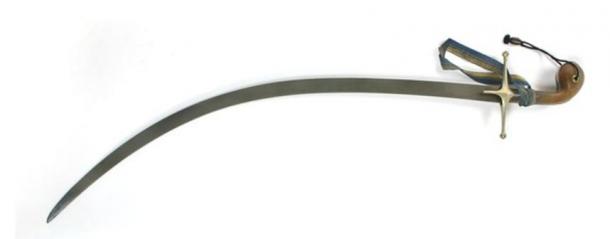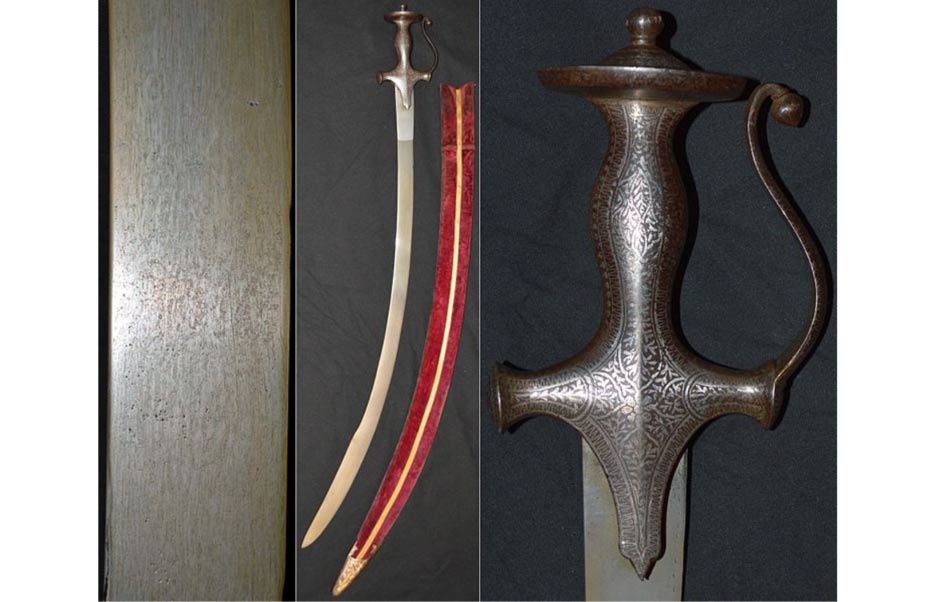Historic Indian sword was masterfully crafted
The master craftsmanship behind Indian swords was highlighted when scientists and conservationists from Italy and the UK joined forces to study a curved single-edged sword called a shamsheer. The study, led by Eliza Barzagli of the Institute for Complex Systems and the University of Florence in Italy, is published in Springer's journal Applied Physics A -- Materials Science & Processing.
The 75-centimeter-long sword from the Wallace Collection in London was made in India in the late eighteenth or early nineteenth century. The design is of Persian origin, from where it spread across Asia and eventually gave rise to a family of similar weapons called scimitars being forged in various Southeast Asian countries.

The 75-centimeter-long shamsheer (shamshir) from the late 18th or early 19th century made in India (Wallace Collection, London). Credit: Dr. Alan Williams
Two different approaches were used to examine the shamsheer: the classical one (metallography) and a non-destructive technique (neutron diffraction). This allowed the researchers to test the differences and complementarities of the two techniques.

A 19 th century Barkandaz (guard) in India with sword by Fanny Parkes Parlby, 1850 (Wikimedia Commons)
The sword in question first underwent metallographic tests at the laboratories of the Wallace Collection to ascertain its composition. Samples to be viewed under the microscope were collected from already damaged sections of the weapon. The sword was then sent to the ISIS pulsed spallation neutron source at the Rutherford Appleton Laboratory in the UK. Two non-invasive neutron diffraction techniques not damaging to artefacts were used to further shed light on the processes and materials behind its forging.
"Ancient objects are scarce, and the most interesting ones are usually in an excellent state of conservation. Because it is unthinkable to apply techniques with a destructive approach, neutron diffraction techniques provide an ideal solution to characterize archaeological specimens made from metal when we cannot or do not want to sample the object," said Barzagli, explaining why different methods were used.

A ‘shamshir’ sword of Persian origin (Wikimedia Commons)
It was established that the steel used is quite pure. Its high carbon content of at least one percent shows it is made of wootz steel. This type of crucible steel was historically used in India and Central Asia to make high-quality swords and other prestige objects. Its band-like pattern is caused when a mixture of iron and carbon crystalizes into cementite. This forms when craftsmen allow cast pieces of metal (called ingots) to cool down very slowly, before being forged carefully at low temperatures. Barzagli's team reckons that the craftsman of this particular sword allowed the blade to cool in the air, rather than plunging it into a liquid of some sort. Results explaining the item's composition also lead the researchers to presume that the particular sword was probably used in battle.
MORE
- 3000-year-old bronze sword discovered in China
- Mysterious Viking Sword Made With Technology From the Future?
- 12th century sword found in Russia may have belonged to Ivan the Terrible
Craftsmen often enhanced the characteristic "watered silk" pattern of wootz steel by doing micro-etching on the surface. Barzagli explains that through overcleaning some of these original 'watered' surfaces have since been obscured, or removed entirely. "A non-destructive method able to identify which of the shiny surface blades are actually of wootz steel is very welcome from a conservative point of view," she added.
Featured image: Indian tulwar, 19th century, North India, probably Rajasthan or Gujerat, crystalline wootz steel blade with a pronounced yelmen. The hardened cutting edge has been fused (scarf welded) to a softer, more flexible heel, a common practice in Indian swords (Wikimedia Commons)
Source: Springer Science+Business Media. "Historic Indian sword was masterfully crafted." ScienceDaily. ScienceDaily, 10 February 2015.


















Comments
Shamsheer is definitley a beautiful sword.
Peace and Love,
Ricky.
Shamsheer means sword in farsi